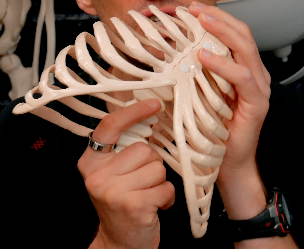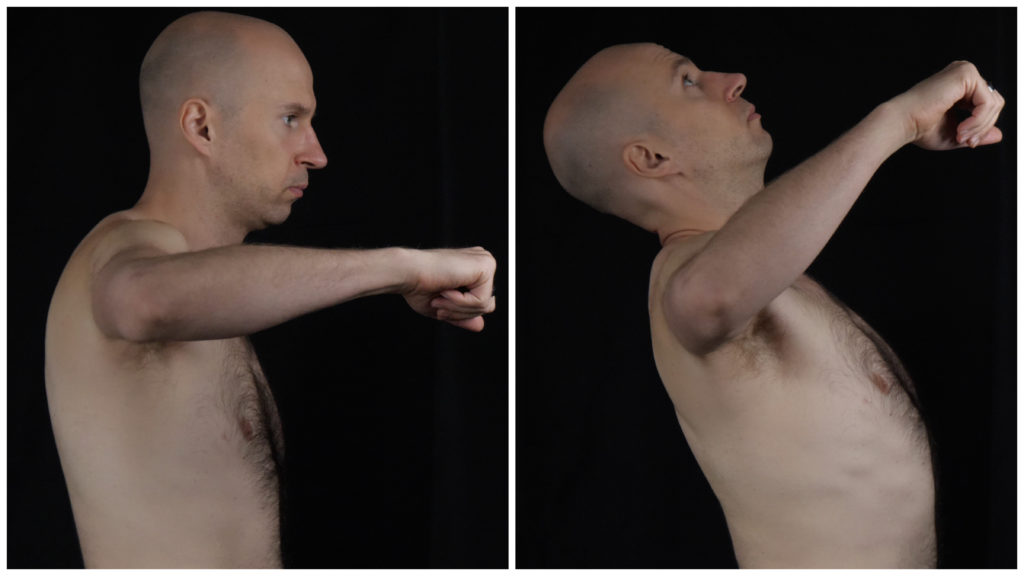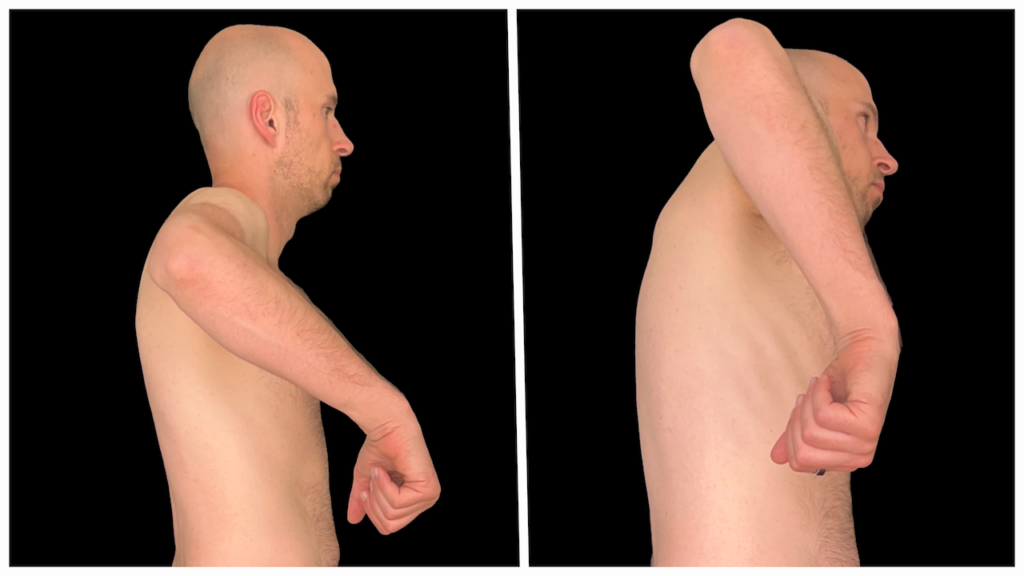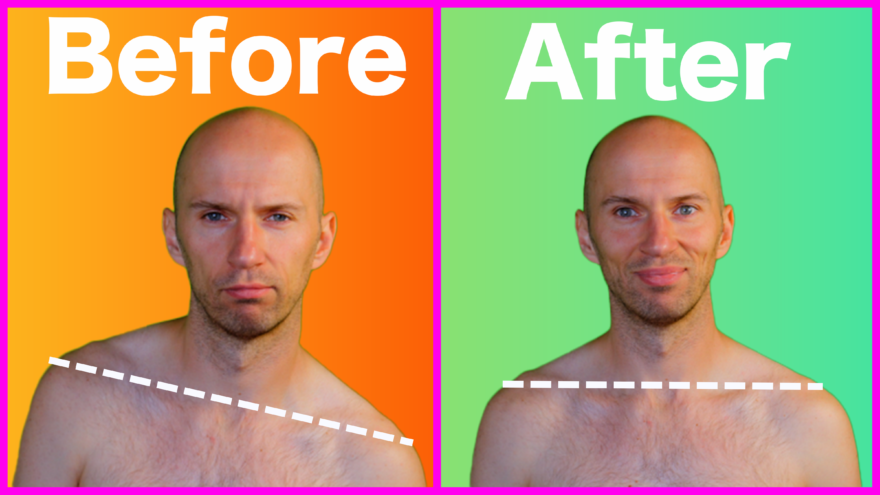Table of Contents
Left vs right-handedness is only one reason your shoulders are asymmetrical
Are you someone whose left shoulder sits lower than the right, and haven’t figured out why or what to do about it?
The problem is that most lack understanding on how this asymmetry occurs, limiting the ability to design effective treatments.
That changes with today’s post. Here, we will dive into the REAL reason the left shoulder may appear lower than the right (and no, it’s not because of handedness), and how to improve this postural strategy.
Check out the video and post below to learn more.
Biomechanics behind uneven shoulders
Based on the normal asymmetry that the human body has, it is actually quite common to have uneven shoulders. More specifically, it is most common to have the right shoulder lower than the left. There are a few reasons for this:
- Organ asymmetry
- General right-sided dominance that could be exacerbated by sport
- The spine has a normal rightward rotation and right sidebend about it
- Increased muscle mass on right in comparison to left
- Potential nerve compromise somewhere (let’s not assume pathology for the sake of this post though)
In fact, these factors could explain why an overwhelming majority of peeps with scoliosis have more of a rightward curve.
But then fam, how does someone create a curve in the opposing direction? One that may exhibit a left shoulder that is lower than the right?
Guess who’s glad you asked? ME!
In the same study above, they demonstrated that left-handed athletes had similar scapular asymmetry in the opposing direction (internally rotated and anteriorly tilted).
But what doesn’t make sense are the axial skeleton variables. We don’t have a situation (or at least rarely) where the organs are flip-flopped, which could create an opposing spinal rotation. So what does?
The answer lies in the ribcage.
How the rib cage influences shoulder posture
It is common for the ribcage to follow a similar path to the spine, in the sense that if the spine is rotated and sidebend to the right, so will the ribcage. Since the scapula sits on the ribcage, it’ll make sense that the right shoulder will be lower than the right.
Now, an interesting thing on spinal mechanics. Again, the article that demonstrated normal rightward spinal rotation also showed that the high thoracic spine (T2-T4) has a predominant leftward rotation. So, theoretically, could the upper part of the ribcage in some folks counter-rotate to the left enough that it gives the appearance of a left shoulder lower than the right?
Some folks argue this exact point, positing that increased right scalene muscle activity could elevate the first several ribs, causing this leftward counter-rotation and opposing appearance.
Respectfully, I disagree. For two reasons.
Reason 1: The first rib is a synarthrodial joint
Synarthroidal means lacking synovial fluid, but instead is fibrous. This difference means that its movement behavior will be different from other corresponding joints. There is NOT a relative movement action that occurs at the first rib.
Instead, when “movement” occurs in the first rib, it will create a levering action of the entire ribcage.
Therefore, if I had a situation (for whatever reasons) where there was a bias towards increased right neck muscle activity, the entire right rib cage would translate upward, and the left would translate downward. It is this action right here that could create a left shoulder that appears lower than the right, as a result of essentially a left sidebend.
You can oftentimes see this when the lower rib cage appears asymmetrical, meaning that the left infrasternal angle appears more medially than the right.
Reason 2: The first 7 ribs have a direct sternal attachment
If the first 7 ribs attach directly to the sternum, then there is a strong likelihood (barring trauma or serious pathology) that these puppies will move together as a unit.
So it seems that we may have a posited mechanism for why the left shoulder would appear lower than the right. My theory:
The left shoulder can appear lower than the right if the rib cage side bends to the left.

Why would this happen? That’s where we have to look at why compensatory sidebending occurs.
Rib cage side bending – Why does it happen?
When I have a loss of relative motion (available motion in a given joint), body regions can orient in a manner to allow joints to move in a manner needed to complete a task.
The easiest example I give of this is someone who lacks shoulder external rotation. If you place your hand in the high five position (bruh) and then tip your thorax backward, you can see that it appears you actually have shoulder external rotation.

But it’s not external rotation that occurs at the glenohumeral joint. Instead, this motion occurs because you oriented the thorax posteriorly.
The same mechanism applies with rib cage side bending. If I have relative motion available at the ribcage (meaning the ribs actually move), side bending will occur to create an internal rotation action on the contralateral side, and an external rotation action on the ipsilateral side.
Meaning, that if I sideband to the left, I will increase available internal rotation space on the right, and external rotation space on the left. You can actually see that in the picture below:

The left sidebend occurs without relative motion. Instead, the rib cage that laterally tilts as a unit to the left. This action creates an orientation that gives the appearance of more available right shoulder internal rotation, though it is not actual IR occuring at the glenohumeral joint.
Think of it this way, for whatever reason, I CANNOT create internal rotation at the right shoulder, so what I can do is side bend away from that side to allow internal rotation to occur. Consequently, you’ll see a loss of shoulder internal rotation on the left side, and a magnification of external rotation on the left. Sneaky, right?!
Now that we know “why” this sidebending action will occur, we have also learned the fix:
- The left shoulder appears lower than the right because the thorax side bends left to increase available right internal rotation
- If you see a left side bend, it is likely because there is a loss of right shoulder internal rotation
- Fix the left sidebend by expanding the right anterior thorax (increasing internal rotation) and the left posterior thorax (increasing external rotation).
How to fix uneven shoulders
There are a few steps required to address the three keys above:
- Restore lower ribcage dynamics (aka stack)
- Expand the right anterior thorax to improve shoulder internal rotation
- Create an eccentric position of the right neck musculature
A right sidelying armbar actually satisfies all three of these criteria, The sidelying position compresses the ribcage laterally, which will promote Anteroposterior ribcage expansion. Given the weighted reach and the head turn to the right, this minimizes right scalene activity.
From here, I would progress that to an elevated side plank, with many of the same attributes as above:
The last piece, to really push the internal rotation gains would be an offset quadruped position:
Sum Up
Now you should have a thorough understanding as to why the left shoulder can appear lower than the left, and what to do about it.
To recap:
- The left shoulder can appear lower than the left if the ribcage sidebends to the left as a unit
- Left sidebending occurs to give the appearance of right shoulder internal rotation
- Interventions should focus on promoting right anterior expansion with lateral ribcage compression, progressively restoring shoulder internal rotation
What struggles have you had with uneven shoulders? Comment below and let the fam know.
